
John Gilbert Baker was an English botanist. His son was the botanist Edmund Gilbert Baker (1864–1949).

Iris reticulata, the netted iris or golden netted iris, is a species of flowering plant in the family Iridaceae. It is native from eastern Turkey to Iran, but cultivated widely in temperate regions. The reticulata group of irises is characterised by a fibrous net surrounding the bulb. They are small plants to 15 centimetres (5.9 in), with tubular, sharply-pointed, ribbed leaves, and flowers of yellow, blue or purple with an orange blaze on the falls, appearing in early spring. They are hardy, but prefer a well-drained sunny position in soil which dries out in summer; they are therefore suitable for a rock or gravel garden.
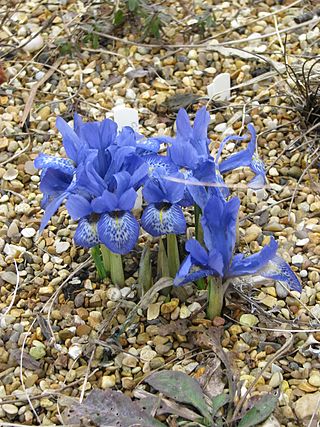
Iris histrioides, the orchis iris, winter iris or Harput iris, is a species of flowering plant in the genus Iris, subgenus Hermodactyloides of the family Iridaceae. It is a bulbous perennial, that is native to Turkey, and has bluish scented flowers. It is cultivated as a plant for ornamental purposes in temperate regions, and has many known cultivars.
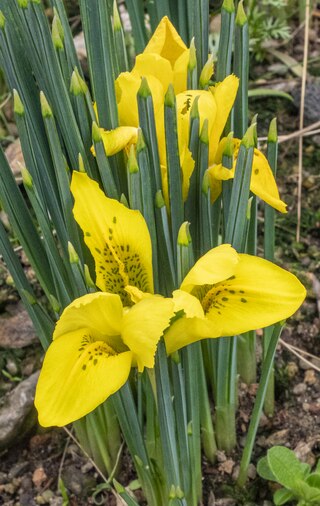
Iris danfordiae, the dwarf iris or Danford iris, is a bulbous perennial plant in the genus Iris, it is classified in the subgenus Hermodactyloides and section Reticulatae. It is from Turkey in Asia. It has 2 gray-green or bluish green, thick leaves, short slender stem holding a scented flower, in shades of yellow. They are spotted olive-green or green and have a deep yellow or orange crest.
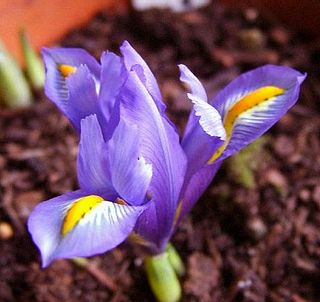
Iris hyrcana, the Hyrcana iris, is a plant species in the genus Iris, it is classified in the subgenus Hermodactyloides and section Reticulatae. It is a bulbous perennial from central Asia, from Azerbaijan to Iran.
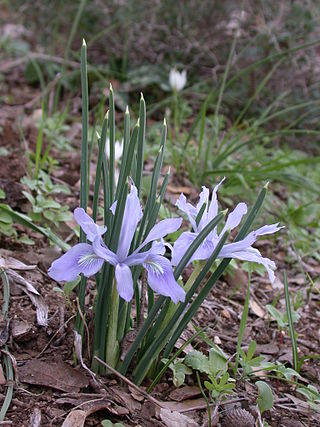
Iris vartanii is a plant species in the genus Iris. It is classified in the subgenus Hermodactyloides and section Reticulatae. It is a bulbous perennial.

Iris histrio, the Syrian iris, is a species in the genus Iris, it is classified in the subgenus Hermodactyloides and section Reticulatae. It is a bulbous perennial from Central Asia: Kyrgyzstan, Israel, Lebanon, Syria and southern Turkey.

Iris orchioides, the 'orchid iris,' is a plant species in the genus Iris, it is also in the subgenus Scorpiris. It is a bulbous perennial, from the mountains of Uzbekistan and Kyrgyzstan. It has dark green leaves, slender stems, up to three yellow flowers in spring. It is cultivated as an ornamental plant in temperate regions.

Iris halophila is a species in the genus Iris. It is also in the subgenus Limniris and in series Spuriae. It is a rhizomatous perennial plant, with yellow, white or violet flowers. It is cultivated as an ornamental plant in temperate regions. It comes from a wide range from eastern Europe to China in Asia. It was known for a long while as a subspecies of Iris spuria, before being treated as a separate species in its own right.
Iris afghanica is a plant species in the genus Iris, it is also in the subgenus Iris and in the section Regelia. It is a rhizomatous perennial, from Afghanistan, with thin bluish-green leaves and creamy yellow or white flowers, that are veined with purple-brown. It has yellow-green or purple beards. Although, in the wild, it can vary in colour and size. It is cultivated as an ornamental plant in temperate regions.
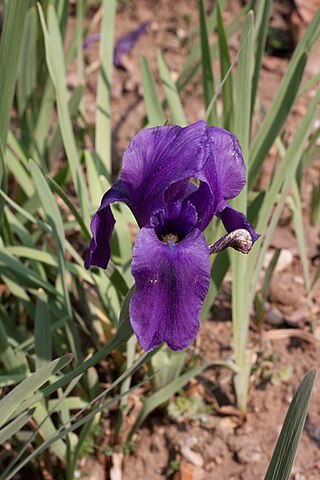
Iris hoogiana is a plant species in the genus Iris, it is also in the subgenus Iris and in the section Regelia. It is a rhizomatous perennial, from the grassy mountainsides of Turkestan. It has long green leaves, which are slightly purple at the base, and a long slender flowering stem. The flowers are blue, ranging from sky-blue to lavender blue and blue purple. It has orange or yellow beards. It is cultivated as an ornamental plant in temperate regions.

Iris korolkowii is a plant species in the genus Iris. It is also in the subgenus Iris and in the section Regelia. It is a rhizomatous perennial, from the mountains of Tien Shan, Pamir and Altai, in Afghanistan and Turkestan. It is commonly known as the Redvein Iris. It has long, sword-shaped grey-green leaves, slender stem, and 2 to 3 white, cream, pale green or light purple flowers which are veined with maroon, chocolate brown or dark purple. It is cultivated as an ornamental plant in temperate regions.
Iris sikkimensis is a plant species in the genus Iris, it is also in the subgenus Iris and in the section Pseudoregelia. It is a rhizomatous perennial, from Sikkim. It has pale green or light green thin leaves, slender stem, 2 or 3 lilac or purple flowers, with a white beard with orange tips. It is thought to be a hybrid of Iris hookeriana and Iris kumaonensis.

Iris acutiloba subsp. lineolata is a species in the genus Iris, it is also in the subgenus of Iris. It is a subspecies of Iris acutiloba, and is a rhizomatous perennial, from the mountains of Iran, Turkey, Turkmenistan, Tajikistan and Azerbaijan. It has narrow, lanceolate, or falcate (sickle-shaped) leaves, which are grey-green and glaucous. It has a slender straight stem holding one terminal flower. The flowers, come in shades of white, cream, or creamy white and have veining that is purple or brown, or a mixture of both. It is heavily veined or streaked in purple or brown, with a dark purple-brown, spot on 3 of the outer petals and brown, dark purple, or black short beard. It is rarely cultivated as an ornamental plant in temperate regions, unless grown in a greenhouse.

Iris acutiloba is a species in the genus Iris, it is also in the subgenus of Iris and section Oncocyclus. It is a rhizomatous perennial, from the mountains of the Caucasus and found in Turkey, Armenia, Azerbaijan, Turkmenistan, Dagestan in the North Caucasus, and Iran. It is a dwarf species, with narrow, falcate or curved leaves, it has one flower in spring or early summer, that comes in shades from cream, creamy white, whitish, pale brown, light grey, to pale violet. It is heavily veined or streaked and pointed, with 2 dark spots and brown, purple, dark purple, or black short beard. It is cultivated as an ornamental plant in temperate regions. There are two subspecies, Iris acutiloba subsp. lineolata and Iris acutiloba subsp. longitepala.
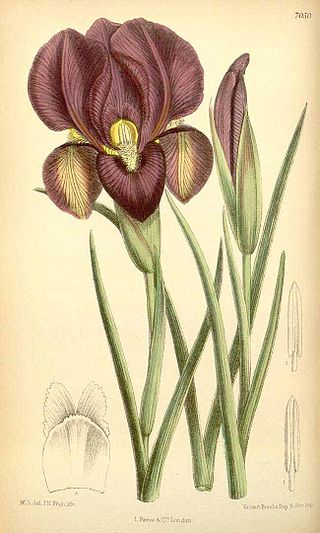
Iris barnumiae is a species in the genus Iris; it is also in the subgenus Iris and in the section Oncocyclus. It is a rhizomatous perennial, from Armenia, Azerbaijan, Iran, Iraq, and Turkey. It has pale glaucous green and narrow leaves, that are slightly sickle-shaped and fade soon after blooming. It has, in mid- to late spring, fragrant flowers in shades of purple, from red-purple, mulberry to purplish-violet, with a yellow tipped with purple beard. It was renamed as I. barnumiae in after a plant naming conference in 2011, but is still sometimes named as I. barnumae in some sources. It has one accepted subspecies Iris barnumiae subsp. demawendica and two forms; Iris barnumiae f. protonyma (Stapf) B.Mathew & Wendelbo and Iris barnumiae f. urmiensis (Hoog) B.Mathew & Wendelbo, which has yellow flowers. Sometimes I. barnumiae f. barnumiae is used to describe the basic form. It is rarely cultivated as an ornamental plant in temperate regions, due to its needing very dry and warm summer conditions.
Iris barnumiae subsp. demawendica is a species in the genus Iris, it is also in the subgenus of Iris and in the Oncocyclus section. It is a rhizomatous perennial, from Elburz Mountains in Iran. It was originally thought to be a separate species before going through various changes before being classed as a subspecies of Iris barnumiae. It has erect, grey-green (grass-like) leaves and two large flowers, which come in shades from claret-red, burgundy, violet-blue, to dark purple, with a white or cream beard. It is rarely cultivated as an ornamental plant in temperate regions, due to the environmental conditions it prefers.
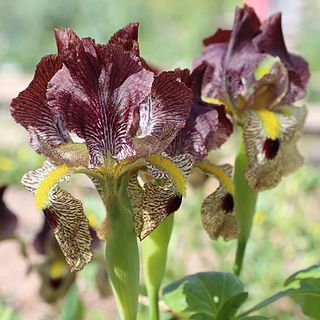
Iris paradoxa is a species of flowering plant native to western Asia. It has large upright petals and smaller lower petals, which is unique amongst most iris forms. They come in various shades from white, lavender, mauve, medium purple, violet, dark purple to black. It has a black or purplish black beard on the lower petals. It comes from the region of Transcaucasia, and is found in the countries of Iran, Turkey, Armenia and in Azerbaijan.

Iris sari is a species in the genus Iris, it is also in the subgenus Iris and in section Oncocyclus. It is from the rocky steppes and hills of Turkey. It has curved or straight leaves, cream, greenish or yellowish flowers which are variable and veined with crimson, purple-brown, reddish brown, reddish-purple or black. It has a dark maroon, rich crimson or brown signal patch and gold or yellow beard.
















